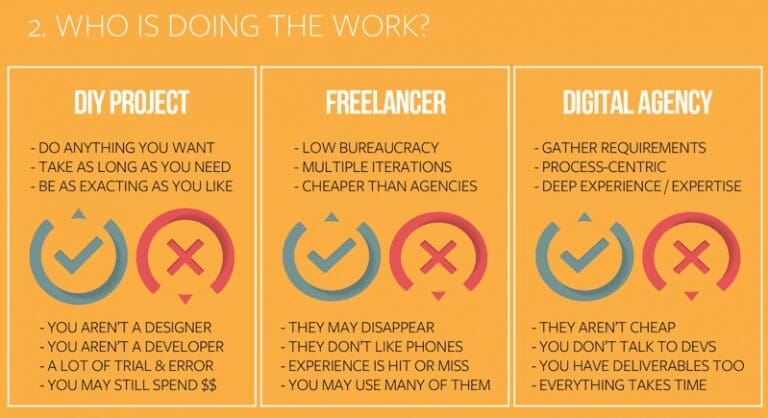
How Much Does a Website Cost? (Updated for 2024!)
Consider It All: Functionality, Page Count, Images & Beyond!
We’ve been building websites for more than 23 years, and this question has been posed to us in a number of ways. In this day and age, it’s more commonly presented as, “what kind of budget range are we looking at – we won’t hold you to anything.”
Such a simple question, but far from an easy one to answer – especially early in the process. But what makes estimating websites so tough? After all, we just bragged about having almost two decades of experience, shouldn’t giving estimates be simple to do at this point?
Well, as Lee Corso is so fond of saying…

Website Cost Factors
To better understand website estimates, one needs to take a closer look at what exactly goes into a website. While certainly not exhaustive, here’s a list of the larger considerations.
Every Website is Custom
When we explain the website development process to clients, we’re fond of comparing the process to that of building a house. There are some very close similarities – you start with a conceptual design process, move to the physical building stage, then work on final touches and aesthetics. But there is a huge breakdown in the comparison.
By definition, every new website built has never existed before. Even if you start with a template, a theme or simply a carbon copy of an existing website, it will always need customized to the needs of the client. And I’ve yet to meet a client that is perfectly fine with a website that looks exactly like someone else’s.
We have made a company decision to use a custom web design on every site we build. We also have an in-house copywriter that gets involved in almost every project in the pipeline. Well, here’s the problem with both – they are subjective. There’s a very real possibility that the client may not like the design or may not connect with what we’ve written. It’s rare, but it can happen.
On the development side, there is far less subjectivity, but still many areas that can skew (and potentially blow up) an estimate:
- Are we connecting to any sort of database or API?
- Are there pages or sections of the site that we don’t know about?
- Is there functionality that isn’t readily apparent when looking through the site?
- Are there things that you are expecting with the new site that aren’t necessarily a “normal” part of a new site build?
It’s Our First Dance Together
 We have clients that give us free reign to “do our thing,” and we have clients that are closely involved with us through every step of the process (and everything in between). We have clients that get annoyed when we email them with our weekly updates, and we have others that would prefer a weekly sit down to talk over everything. We are fine with either approach, but one obviously takes more time and resources than the other.
We have clients that give us free reign to “do our thing,” and we have clients that are closely involved with us through every step of the process (and everything in between). We have clients that get annoyed when we email them with our weekly updates, and we have others that would prefer a weekly sit down to talk over everything. We are fine with either approach, but one obviously takes more time and resources than the other.
It’s hard to pinpoint exactly where a new client will fall within that scale, just as it’s difficult to determine just how particular a new client will be with design and content. When asked to give a budget number “off the cuff,” we pretty much have to take a conservative approach and assume that the project will skew toward the higher end of the scale.
Once we’ve worked with a client and have a better idea how they operate, we can get much more accurate with initial budget numbers. The fewer the variables, the sharper our numbers.
The Intangibles (and The Issue with RFPs)
This is a bit of a tangent, but I promise I’ll bring it back around – so stick with me here.
We hate RFPs (Request For Proposals). We don’t hate them because of all the work it takes to put one together, we hate them because the position it puts the bidder in and what the client gets out of it.
From a bidder’s perspective, the goal in answering an RFP is to provide the absolute minimum to meet the criteria of the RFP which keeps our pricing as sharp as possible. After all, with most RFP situations, you never even get an opportunity to sell your company or your capabilities unless you make the cut and are granted a meeting. Price is typically a huge determining factor in making the cut, so it doesn’t make any sense to quote anything other than the minimum.
I completely get that approach when purchasing commodities. If you can get paper towels, iPhones or passenger jets cheaper by inviting companies to bid on them – good for you. After all, an iPhone 13 is always an iPhone 13, regardless of who you purchase it from. But a website is not a commodity. How it’s built – and what is built – can vary significantly from company to company. You simply cannot write an RFP stringently enough to guarantee the exact same result regardless of developer.
The bigger issue is that there are other services that we can provide that can help you get more from your site and turn it from an expense to a revenue producer. Our digital marketing campaigns have helped companies grow exponentially – they are easily the highest ROI items we offer. But when asked about budget numbers without really understanding if a client would benefit from digital marketing, we typically don’t include them and it could be the determination between success and failure.
The truth is, we offer quite a number of services that we can’t possibly know to recommend until we learn more about your company, your site and your audience.
If you’re still determined to issue an RFP (we get it, sometimes there’s no way around it), check out our post, “The Best Website Redesign RFP for 2022 – and Beyond“.
Don’t Compare Apples to Ferrets
 Yes, we are well aware that there are sites where people can create their own website, often for free. And those sites are fine for family reunions, Britney Spears tributes and the like, but not for legitimate businesses that are hoping to garner visitors, leads and income.
Yes, we are well aware that there are sites where people can create their own website, often for free. And those sites are fine for family reunions, Britney Spears tributes and the like, but not for legitimate businesses that are hoping to garner visitors, leads and income.
There are also freelancers, overseas companies and start-ups that will offer to build a site for next to nothing. But to compare any of them to an established firm is not even close to an apples to apples comparison.
A few things to consider:
- Would you let your architect also physically build your house? Or have your builder create the architectural drawings? Not saying there aren’t people out there who can’t do both, but either practice takes a lifetime to master. Finding a master of both is as common as unicorns.
- User interface, user experience, color theory, conversion rate optimization – these are all website development factors that make a huge difference. But they aren’t free.
- Professional project managers, designers, content writers, SEO experts – these people are all vital to the success of your project. But again, not free.
- There is a VERY low barrier to entry for website developers. A person could literally install one WordPress template and then hold themselves out as a website developer. Experience in this business is crucial and reduces the chance that you’ll be anyone’s guinea pig.
This is a great graphic from a similar article posted on LiquidWeb:

In short, make sure you are comparing similar firms. An experienced digital agency will never be as cheap as that overseas company, but there’s a much better chance you’ll get a higher return on your investment with less headaches along the way.
Seriously, How Much Does a Website Cost?
I know, I know – people still want an estimate. And I completely get it. After all, I wouldn’t drop my car off for repairs unless I had some idea of what I was getting myself into.
With no further ado, here are some ROUGH ideas of what you can expect – but bear in mind that there are many factors that can skew these numbers!
Small website: ~ 10 pages, custom design
$5,000 – $10,000
Business website/basic eCommerce website: ~ 30 pages, custom design, mobile optimized, on-page SEO
$15,000 – $30,000
Professional website: ~ 40+ pages, custom design, content strategy, SEO
$35,000 – ?
Wide ranges, to be sure, but without specifics on what is needed, it’s next to impossible to get much closer. The good news is that none of these ranges are “set in stone;” we’ve completed sites with 100 pages within the middle range, but we’ve also done small sites that exceed the small website range.
A Final Recommendation
Most web firms (ForeFront included) offer a Discovery Session. Essentially, it’s the beginning process of any project and typically includes the following:
- Meet and greet of all parties involved
- In-depth discussion of the project and any intricacies
- Work through of decision points and site options
- Development of a sitemap and sometimes wireframes
- Creation of a full Scope of Work
- Establishment of milestones and a working schedule
You’ll pay for the session (roughly $3k – $5k), but from it you’ll have a much better (and more accurate) scope of work and associated quote. It also gives you a great opportunity to get to know your web firm and decide whether you will like working with them. In a worst case scenario, you’ll walk away from the discovery session with tangible items that you can take to another firm, so you’ll be ahead of the game.
Have questions about website prices? Need a better idea of what your specific project will cost? We LOVE learning about new projects and would be happy to chat with you. Hit us up today and let’s get the conversation started!
GET A CUSTOM WEBSITE REDESIGN QUOTE TODAY
